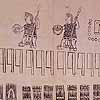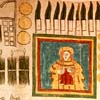
Introduction
The Library of Congress is an extraordinary resource for substantive primary research in virtually any field or area of Hispanic and Portuguese studies (commonly referred to as Luso-Hispanic studies after the Latin names for both entities of the Iberian Peninsula, i.e., Portugal was Lusitania and Spain was Hispania), encompassing Latin America, the Caribbean, Hispanics and Portuguese in the United States, the Iberian Peninsula, and other places where Iberian culture dominated and has survived. I will interchangeably refer to our collections as Hispanic and Portuguese collections or as Luso-Hispanic collections. Within its total Hispanic and Portuguese collections of ten million items are an estimated one million related books and periodicals on Latin America alone and an equal number for the Iberian Peninsula and the rest of the Luso-Hispanic world. For books, maps, and for retrospective holdings of government serials (national and provincial), newspapers, and other periodicals, these are the most extensive collections in the world. So voluminous and diverse are the Library's Luso-Hispanic holdings that it is practically impossible to itemize or categorize adequately significant topical or geographic strengths. Suffice it to say that visiting Iberian and Latin American scholars consistently report the discovery of materials in the Library of Congress that are not available in their home countries.
![Thumbnail image of Vue de la Place
vieille/Vista de la Plaza Vieja [Havana,
Cuba]](hst04001.jpg) Vue de la Place vieille/Vista de la Plaza Vieja [Havana,
Cuba]. In Hippolite J. B. Garnerey. Vues de la Habana. Paris
1830. The industrious, bustling, multicultural center of trade
in Havana is depicted in this view. Additional information about
the city, with various cultural information provided, appears in
the work, which provides a period snapshot of nineteenth-century
urban Cuba. (Geography and Map Division)
Vue de la Place vieille/Vista de la Plaza Vieja [Havana,
Cuba]. In Hippolite J. B. Garnerey. Vues de la Habana. Paris
1830. The industrious, bustling, multicultural center of trade
in Havana is depicted in this view. Additional information about
the city, with various cultural information provided, appears in
the work, which provides a period snapshot of nineteenth-century
urban Cuba. (Geography and Map Division)
The Library of Congress's collections reflect admirably on the early wishes of the Congress of the United States to remain informed about the cultures, places, things, and societies outside of the territory of the United States that affect our society, either through direct contact or from afar. At its inception in 1800 the Library of Congress reflected a worldview in its collecting patterns, even before the acquisition of Thomas Jefferson's personal library in 1815, following the destruction of the Library by invading British forces. Over these past two hundred years the Library of Congress's Hispanic and Portuguese collections have become unparalleled in their content, breadth, and scope.
These Hispanic and Portuguese collections describe broadly and deeply Native American cultures; the cultures of the independent states of Latin America and the Caribbean; the colonial histories of Spain, Portugal, France, and England in what is now the Caribbean, the United States, and Latin America; a myriad body of material on the literature, art, law, and politics of the Iberian Peninsula; and a treasure trove of rare books, manuscripts, and maps about Spanish and Portuguese exploration, discovery, and expansion globally, from Lucena's 1488 work on Portuguese exploration and Christopher Columbus's own 1502 manuscript book of privileges, to contemporary manuscript accounts of Pedro Alvares Cabral's voyage to Brazil and India in 1500.
![Thumbnail image of First page. In
[Christopher Columbus] [Códice Diplomático
Columbo-Americano]. Vellum. [Sevilla, ca. 1502].](hst07001.jpg) First page. In [Christopher Columbus] [Códice
Diplomático
Columbo-Americano]. Vellum. [Sevilla, ca. 1502] Undoubtedly the
Library of Congress's most prized early Americana. The volume
cited is commonly referred to as Columbus's Book of Privileges.
On January 5, 1502, Columbus gathered at his home in Seville two
local judges and three notaries to authorize the preparation of
authentic copies of his archival collection of documents by which
Queen Isabel and King Fernando had granted titles, revenues,
powers, and privileges to him and his descendants. Columbus was
then preparing to embark on his fourth and final voyage to
America. Through this compilation he hoped to protect his future
interest in wealth and honors by placing authenticated copies of
these documents in trusted hands. We know that four copies of
his compilation existed in 1502, three written on vellum and one
on paper. The Library of Congress copy, acquired from William
Everett in 1901, is the only example in the Western Hemisphere
and is the one item in the Library's collection known to have
been in Columbus's hands. A unique copy of the September 26,
1493 Papal Bull Dudum siquidem distinguishes the Library of
Congress copy of the Book of Privileges from all others. The
other two vellum copies are located in Paris and in Genoa.
(Manuscript Division)
First page. In [Christopher Columbus] [Códice
Diplomático
Columbo-Americano]. Vellum. [Sevilla, ca. 1502] Undoubtedly the
Library of Congress's most prized early Americana. The volume
cited is commonly referred to as Columbus's Book of Privileges.
On January 5, 1502, Columbus gathered at his home in Seville two
local judges and three notaries to authorize the preparation of
authentic copies of his archival collection of documents by which
Queen Isabel and King Fernando had granted titles, revenues,
powers, and privileges to him and his descendants. Columbus was
then preparing to embark on his fourth and final voyage to
America. Through this compilation he hoped to protect his future
interest in wealth and honors by placing authenticated copies of
these documents in trusted hands. We know that four copies of
his compilation existed in 1502, three written on vellum and one
on paper. The Library of Congress copy, acquired from William
Everett in 1901, is the only example in the Western Hemisphere
and is the one item in the Library's collection known to have
been in Columbus's hands. A unique copy of the September 26,
1493 Papal Bull Dudum siquidem distinguishes the Library of
Congress copy of the Book of Privileges from all others. The
other two vellum copies are located in Paris and in Genoa.
(Manuscript Division)
 Warriors enlisted for military campaign. Amate paper.
Huexotzinco Codex. 1531. A codex, a Mesoamerican written document
containing historical, calendrical, or other forms of
information, is pre-European in origin. The codices were made by
a writer known as the tlacauilo who had stature in the community.
With the arrival of the Spaniards, the use of the codex as a
written form gradually diminished during the sixteenth century as
the romanized written Mexica (nahuatl) replaced it. In the
Huexotzinco Codex one can see a number of interesting features of
the Indian society, e.g., in the plate displayed, the use of the
banner or flag represents the number twenty and therefore each
flag refers to twenty warriors. Other sheets of the codex
provide additional symbols for the numbers 400 and 8000. The
Huexotzinco Codex is among the priceless documents found in the
Harkness Collection, given to the Library of Congress in 1928 and
1929. (Harkness Collection, Manuscript Division)
Warriors enlisted for military campaign. Amate paper.
Huexotzinco Codex. 1531. A codex, a Mesoamerican written document
containing historical, calendrical, or other forms of
information, is pre-European in origin. The codices were made by
a writer known as the tlacauilo who had stature in the community.
With the arrival of the Spaniards, the use of the codex as a
written form gradually diminished during the sixteenth century as
the romanized written Mexica (nahuatl) replaced it. In the
Huexotzinco Codex one can see a number of interesting features of
the Indian society, e.g., in the plate displayed, the use of the
banner or flag represents the number twenty and therefore each
flag refers to twenty warriors. Other sheets of the codex
provide additional symbols for the numbers 400 and 8000. The
Huexotzinco Codex is among the priceless documents found in the
Harkness Collection, given to the Library of Congress in 1928 and
1929. (Harkness Collection, Manuscript Division)
 Products and services provided as tribute, including a banner
with Madonna and Child. Amate paper. Huexotzinco Codex. Indian
peoples of Mexico were accustomed to paying tribute to the pre-European
Mexica (Aztec) Empire and that custom prevailed during
the Spanish period. The people of Huexotzinco, along with
Hernando Cortés, won a legal suit against the Spanish crown who
had imposed excessive taxes. The Huexotzinco Codex, prepared in
the time-honored fashion of pre-European Meso America, is the
graphic portion of the lawsuit. The sheet depicted contains one
of the earliest known images of the Madonna and Child in this
type of document, a representation of an expensive banner made of
precious feathers and gold. Produced only ten years after
Conquest, it is a valuable document for a deeper understanding of
the dramatic transitions that took place during Mexico's early
colonial period. (Harkness Collection, Manuscript Division)
Products and services provided as tribute, including a banner
with Madonna and Child. Amate paper. Huexotzinco Codex. Indian
peoples of Mexico were accustomed to paying tribute to the pre-European
Mexica (Aztec) Empire and that custom prevailed during
the Spanish period. The people of Huexotzinco, along with
Hernando Cortés, won a legal suit against the Spanish crown who
had imposed excessive taxes. The Huexotzinco Codex, prepared in
the time-honored fashion of pre-European Meso America, is the
graphic portion of the lawsuit. The sheet depicted contains one
of the earliest known images of the Madonna and Child in this
type of document, a representation of an expensive banner made of
precious feathers and gold. Produced only ten years after
Conquest, it is a valuable document for a deeper understanding of
the dramatic transitions that took place during Mexico's early
colonial period. (Harkness Collection, Manuscript Division)
Special thanks are extended to Georgette Dorn, Chief, and specialists Everette Larson, Barbara Tenenbaum, and Iêda Siqueira Wiarda whose suggestions and additions have improved this work. Additionally, I appreciate the assistance of the specialists in the Library's various special collections who willingly provided invaluable information about Luso-Hispanic materials in their rich collections and of Iris Newsom, editor, Publishing Office, whose deft hand and critical eye have immeasurably improved this work. Finally, to you the user of the guide, I hope that it provides to you a brief but enticing glimpse to the dimensions of the treasures and the resources that comprise the Library of Congress
John R. Hébert Senior Specialist in Hispanic Bibliography Hispanic Division
Ask a Librarian (08/19/2004)